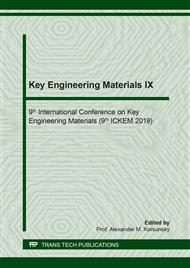[1]
J. H. Tibbetts, Managing Marine Plastic Pollution: Policy Initiatives to Address Wayward Waste,, Environ. Health Perspect., vol. 123, no. 4, pp. A90–A93, Apr. (2015).
DOI: 10.1289/ehp.123-a90
Google Scholar
[2]
W. C. LI, H. F. TSE, and L. FOK, Plastic waste in the marine environment: A review of sources, occurrence and effects,, Sci. Total Environ., vol. 566–567, p.333–349, Oct. (2016).
DOI: 10.1016/j.scitotenv.2016.05.084
Google Scholar
[3]
Greenpeace: PH is third worst plastic polluter of oceans,, Agence France-Presse, 23-Sep-(2017).
Google Scholar
[4]
A. Merkl, Stemming the Tide: Land-based strategies for a plastic-free ocean,, (2015).
Google Scholar
[5]
J. R. Jambeck et al., Plastic waste inputs from land into the ocean,, Science (80-. )., vol. 347, no. 6223, p.768 LP-771, Feb. (2015).
DOI: 10.1126/science.1260352
Google Scholar
[6]
Philippine Solid Wastes,, Manila, (2017).
Google Scholar
[7]
J. Arutchelvi, M. Sudhakar, A. Arkatkar, M. Doble, S. Bhaduri, and P. V. Uppara, Biodegradationof polyethylene and polypropylene,, Indian J. Biotechnol., vol. 7, p.9–22, (2008).
Google Scholar
[8]
Plastics recycling: Economic and Ecological Options,, ICPE, 2006. [Online]. Available: http://www.envis-icpe.com.
Google Scholar
[9]
A. A. Shah, F. Hasan, A. Hameed, and S. Ahmed, Biological degradation of plastics: A comprehensive review,, Biotechnol. Adv., vol. 26, no. 3, p.246–265, May (2008).
DOI: 10.1016/j.biotechadv.2007.12.005
Google Scholar
[10]
H. Cui, R. Hanus, and M. R. Kessler, Degradation of ROMP-based bio-renewable polymers by UV radiation,, Polym. Degrad. Stab., vol. 98, no. 11, p.2357–2365, Nov. (2013).
DOI: 10.1016/j.polymdegradstab.2013.08.003
Google Scholar
[11]
J. Tong, Quantifying Color Difference: A Comparison betwen Spatial Frequency Domain Imagine to Digital Color Imaging in Assessment of Reconstructive Flap Occlusions,, UCI Undergrad. Res. J., p.45–54, (2015).
Google Scholar
[12]
N. Lucas, C. Bienaime, C. Belloy, M. Queneudec, F. Silvestre, and J.-E. Nava-Saucedo, Polymer biodegradation: Mechanisms and estimation techniques – A review,, Chemosphere, vol. 73, no. 4, p.429–442, Sep. (2008).
DOI: 10.1016/j.chemosphere.2008.06.064
Google Scholar
[13]
B. Singh and N. Sharma, Mechanistic implications of plastic degradation,, Polym. Degrad. Stab., vol. 93, no. 3, p.561–584, Mar. (2008).
Google Scholar
[14]
S. Chinaglia, M. Tosin, and F. Degli-Innocenti, Biodegradation rate of biodegradable plastics at molecular level,, Polym. Degrad. Stab., vol. 147, p.237–244, Jan. (2018).
DOI: 10.1016/j.polymdegradstab.2017.12.011
Google Scholar
[15]
H. C. Obasi, I. O. Igwe, and I. C. Madufor, Effect of Soil Burial on Tensile Properties of Polypropylene/Plasticized Cassava Starch Blends,, Adv. Mater. Sci. Eng., vol. 2013, p.5, (2013).
DOI: 10.1155/2013/326538
Google Scholar
[16]
J. Sarasa, J. M. Gracia, and C. Javierre, Study of the biodisintegration of a bioplastic material waste,, Bioresour. Technol., vol. 100, p.3764–3768, (2009).
DOI: 10.1016/j.biortech.2008.11.049
Google Scholar
[17]
Y. Tokiwa, P. B. Calabia, U. C. Ugwu, and S. Aiba, Biodegradability of Plastics,, International Journal of Molecular Sciences , vol. 10, no. 9. (2009).
DOI: 10.3390/ijms10093722
Google Scholar
[18]
S. M. Emadian, T. T. Onay, and B. Demirel, Biodegradation of bioplastics in natural environments,, Waste Manag., vol. 59, p.526–536, (2017).
DOI: 10.1016/j.wasman.2016.10.006
Google Scholar
[19]
A. G. Montecillo, J. Bayogan, J. Natividad, and L. J. L. Diaz, Thermal Analysis of Commercial Plastic Utensils with Claims of Biodegradability,, Diliman, Quezon City, (2017).
Google Scholar
[20]
M. R. Jung et al., Validation of ATR FT-IR to identify polymers of plastic marine debris, including those ingested by marine organisms,, Mar. Pollut. Bull., vol. 127, p.704–716, (2018).
DOI: 10.1016/j.marpolbul.2017.12.061
Google Scholar
[21]
J. Coates, Interpretation of Infrared Spectra, A Practical Approach,, in Encyclopedia of Analytical Chemistry, R. A. Meyers, Ed. Chichester: John Wiley & Sons, Ltd, 2000, p.10815–10837.
Google Scholar
[22]
R. O. Ebewele, Polymer Science and Technology. New York: CRC Press, (2000).
Google Scholar


